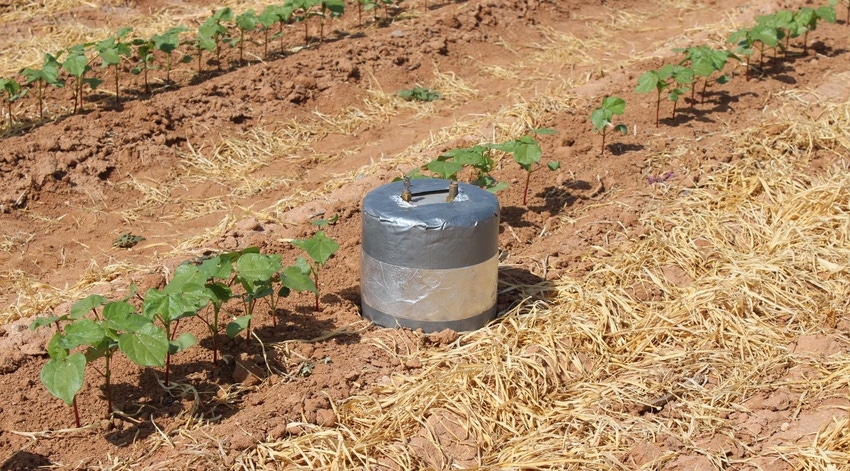
Drip, furrow or overhead?
The debate goes on -- but with new research information concerning the irrigation of cotton to maximize water use and yield potential. Cotton is a drought-tolerant, salt-tolerant crop that generally responds well to irrigation. How it gets that water is the matter in question.
Kevin Bronson has been conducting subject research in Texas and Arizona for over two decades, recently concluding multiple-year field studies on surface furrow, overhead sprinkler, and subsurface drip irrigation and its application to nitrogen management.
“Historically, Arizona cotton crops have been furrow-irrigated with both groundwater and Central Arizona Project water, but severe drought has led to low water levels requiring cutbacks in CAP allocation for Central Arizona cotton farmers,” he notes.
Not a new technology
“Drip isn’t a new technology in Arizona as some farms have been using it for years in variations of 6 to 8, 10, or 12 inches deep. It’s really the Cadillac of irrigation systems,” says the soil scientist with Maricopa’s USDA Arid Land Agriculture Research Center.
Essentially, it’s a relatively small amount of water underground. It doesn’t run off. It doesn’t evaporate.
“Drip is a good, climate-friendly, cotton farming practice in places where cropping is nearly 100 percent irrigated,” Bronson says. “There’s a little bit of dry land growing on the Navajo reservation and a little bit of rain-fed in the Verde Valley, but in Central Arizona, it’s all irrigated and subsurface is the predominant form.
“We do very little surface irrigation research anymore because there is a definite movement toward more efficient irrigation systems especially when you’re irrigating about five inches every ten days,” he says.
“You don’t get deep-leaching losses with sprinklers, but you still have some evaporative loss before the water gets to the ground and when you have a wet, full surface, you’ll still get evaporation. But with subsurface drip, you can irrigate daily because you’ve eliminated evaporation. It also opens the door to a very efficient fertigation process.”
Cover cropping for healthy soil
Irrigated cover cropping, like small grain over the winter before you plant cotton in April, also helps build up fruitful and structured soil. There’s a nice overnight carpet of residue that also minimizes dust.
“While overhead sprinkler systems result in 1,800 lint pounds per acre, we’re getting four bale fields of 2,000 lint pounds per acre and we’re saving water,” he says. “Although drip systems can be costly at initial installation, there’s a per-acre economy of scale where it’s cheaper to do a thousand acres than it would be to do only a couple hundred.”
In one experiment [Toro.com, Drip Irrigation on Cotton], a third-generation cotton farmer in Lubbock, Texas, who cultivates 3,500 acres, irrigated with both pivot and subsurface drip.
“We have limited water supplies and wind is a big factor here,” Bronson noted. “I can get three bales per acre with 16 inches of drip water, but only 2 ¼ bales per acre with pivot using that same amount of water.”
Bronson’s research has also shown nitrogen efficiency with drip system fertigation measures up well. “We’re getting 90% in contrast to about 40% for overhead sprinklers and a measly 20% with surface irrigation,” he says.
His investigators are also keeping an eye on experiments with a desert perennial shrub native to Texas and northern Mexico -- guayule -- in which drip irrigation has produced a doubling of yield. They’re hoping to emulate a similar increase in their own biomass.
“With drip, we’re seeing greater increases than we’ve seen for some time and it’s our challenge to get nitrogen uptake translated into higher biomass like some colleagues in Australia who are reporting five bales per acre,” he says.
Soil sensors
Moisture probes play an important part in the process with soil sensors indicating when plants are thirsty. Drip plays a part here, too, in the placement and maintenance of water in the cotton root zone. Drip has proven itself in holding water in the top of the root zone, controlling how much depth to be applied by adjusting the timing of the irrigation.
Many growers incorporate the drip system deep enough to allow tillage, but shallow enough to germinate a crop with drippers a foot apart so growers can water up their crop.
“Subsurface drip offers multiple benefits like high water- and nitrogen-use efficiency, soil health and conservation, and lower greenhouse gas emissions that mean sustainable cotton production practices going forward.”
About the Author(s)
You May Also Like




